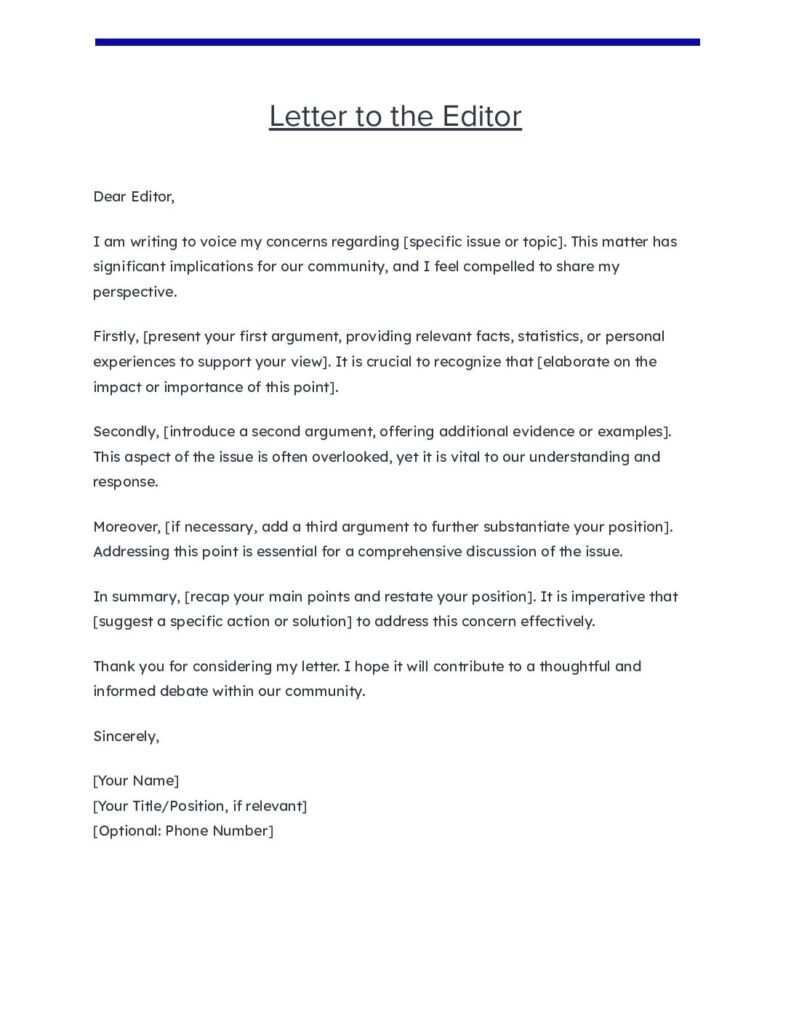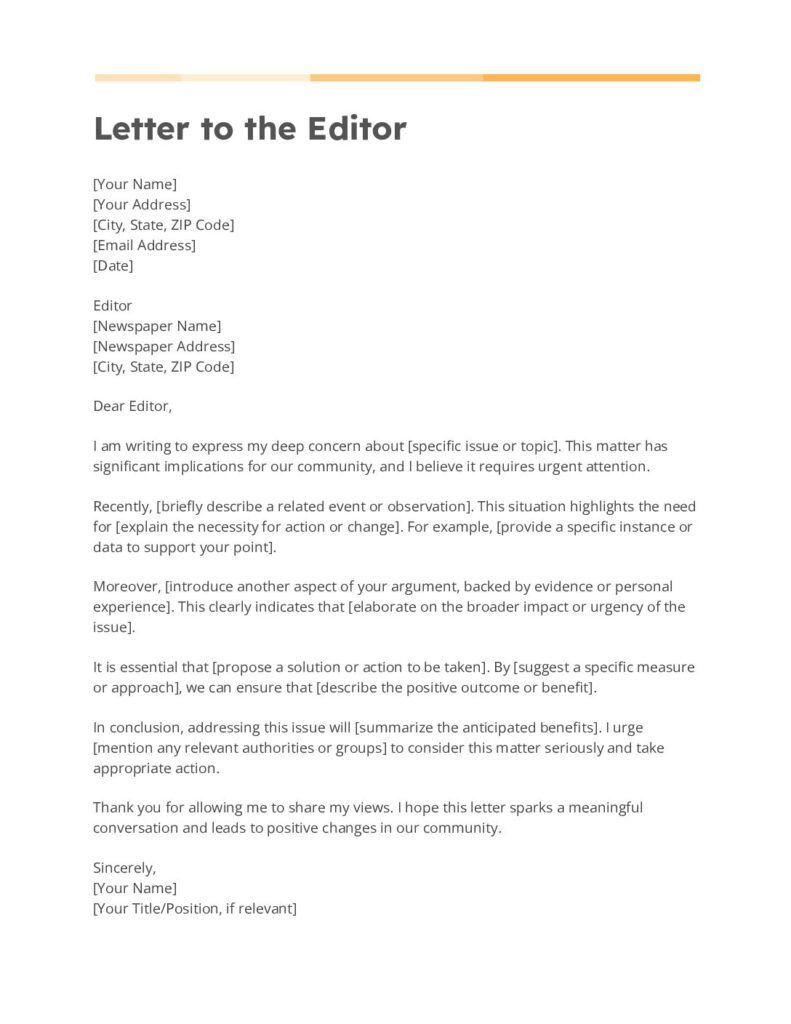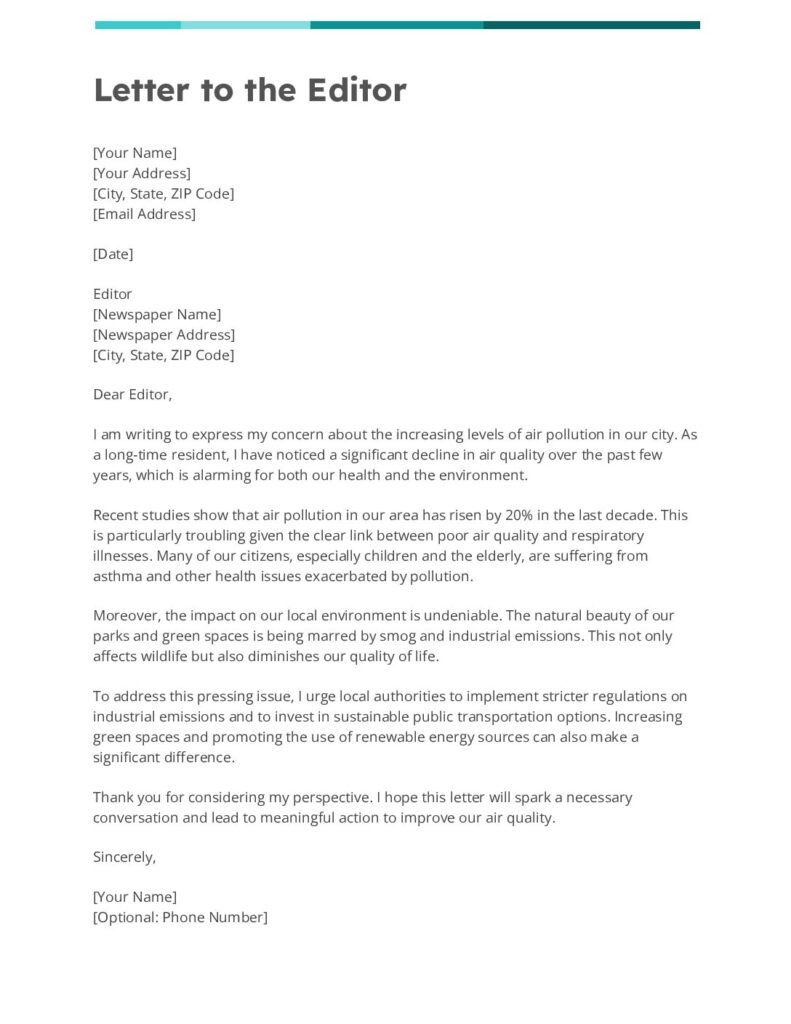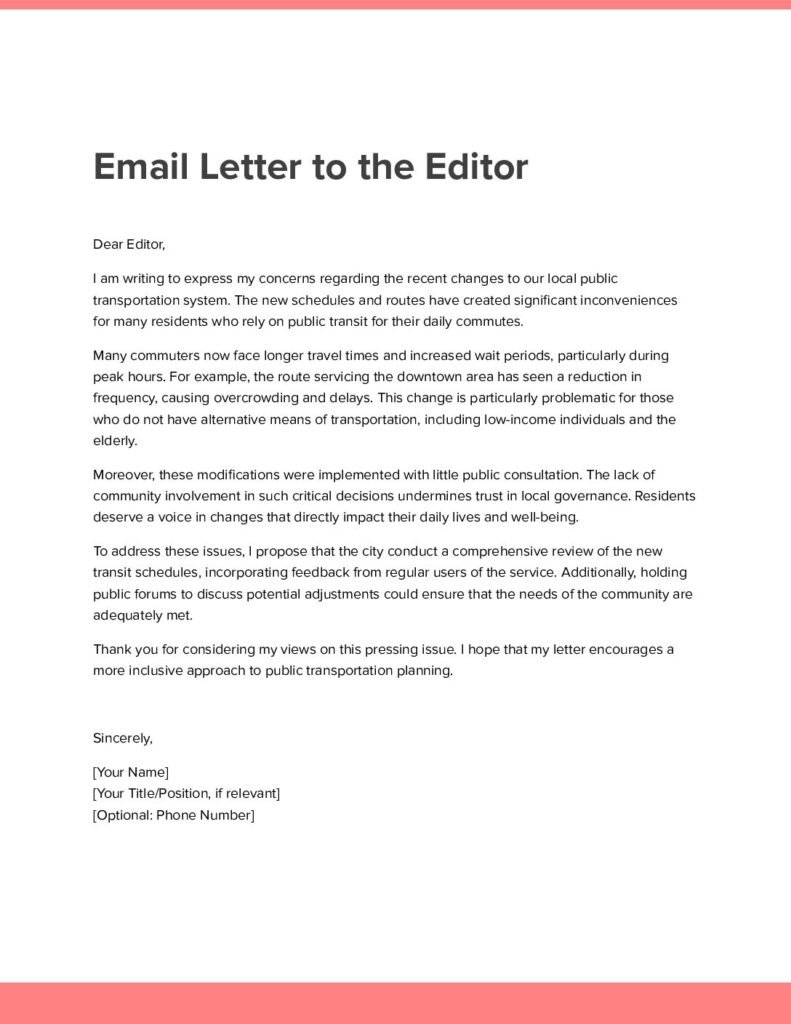Explore our complete guide on writing compelling Letters to the Editor. Discover high-quality templates, examples, and samples designed to ensure your opinions and concerns are effectively voiced in local newspapers and magazines. Our resources are printable, editable, and downloadable in PDF, Word, and Google Docs formats, all completely free. Whether advocating for change, sharing insights, or responding to current events, these tools will empower you to craft letters that get noticed and published.
- Letter to the Editor Format
- Example of Letter to the Editor
- General Letters to Editor
- Letter to the Editor Template
- Sample Letter to the Editor
- Basic letter to the Editor
- Simple letter to the Editor
- Email Letter to the Editor
- Specific Purpose Letters to the Editor
- Content Focus Letters to the Editor
- Letters to Editor by Publication Type
- Letters to Editor by Writing Style
- What is Letter to the Editor?
- How to Write a Letter to the Editor?
- Tips for Writing a Letter to Editor that Stands out
- Standard Guidelines for Letter to the Editor
Letter to the Editor Templates, Examples & Samples
Letter to the Editor Format
[Your Name]
[Your Address]
[City, State, ZIP Code]
[Email Address]
[Date]
Editor
[Newspaper Name]
[Newspaper Address]
[City, State, ZIP Code]
Dear Editor,
I am writing to express my views on [specific issue or topic]. [Briefly state your position and why you are writing about this issue].
[Provide supporting arguments or evidence to back up your position. This can include facts, statistics, personal anecdotes, or references to recent events].
[Conclude with a call to action or a summary of your main points. You might also suggest what you believe should be done to address the issue].
Thank you for considering my perspective. I hope that my letter will contribute to a broader discussion on this important topic.
Sincerely,
[Your Name]
[Your Title/Position, if relevant]
[Optional: Phone Number]
Example of Letter to the Editor
Jane Doe
123 Main Street
Anytown, CA 12345
jane.doe@email.com
June 1, 2024
Editor
Anytown Gazette
456 Broad Street
Anytown, CA 12345
Dear Editor,
I am writing to express my concern about the recent increase in local property taxes. As a homeowner and long-time resident of Anytown, I believe that these tax hikes place an undue burden on our community, particularly on senior citizens and young families who are already struggling to make ends meet.
Recent data shows that property taxes in Anytown have increased by 15% over the past two years. This rise is disproportionate compared to the average income growth in our area, which has been stagnant. For many residents, this means making tough choices between essential needs and paying their tax bills.
Furthermore, the allocation of these funds remains unclear. Transparency in how our tax dollars are being used is crucial. The local government should provide detailed reports to justify these increases and ensure that the funds are benefiting the community in tangible ways, such as improving public services and infrastructure.
I urge the city council to reconsider these tax hikes and explore alternative funding methods that do not disproportionately affect vulnerable populations. Additionally, implementing regular town hall meetings to discuss budget allocations and hear residents' concerns would foster a more inclusive decision-making process.
Thank you for considering my perspective. I hope that my letter will contribute to a broader discussion on this important topic.
Sincerely,
Jane Doe
Concerned Homeowner
General Letters to Editor
Letter to the Editor Template

[Your Name]
[Your Address]
[City, State, ZIP Code]
[Email Address]
[Date]
Editor
[Newspaper Name]
[Newspaper Address]
[City, State, ZIP Code]
Dear Editor,
I am writing to voice my concerns regarding [specific issue or topic]. This matter has significant implications for our community, and I feel compelled to share my perspective.
Firstly, [present your first argument, providing relevant facts, statistics, or personal experiences to support your view]. It is crucial to recognize that [elaborate on the impact or importance of this point].
Secondly, [introduce a second argument, offering additional evidence or examples]. This aspect of the issue is often overlooked, yet it is vital to our understanding and response.
Moreover, [if necessary, add a third argument to further substantiate your position]. Addressing this point is essential for a comprehensive discussion of the issue.
In summary, [recap your main points and restate your position]. It is imperative that [suggest a specific action or solution] to address this concern effectively.
Thank you for considering my letter. I hope it will contribute to a thoughtful and informed debate within our community.
Sincerely,
[Your Name]
[Your Title/Position, if relevant]
[Optional: Phone Number]
Sample Letter to the Editor

[Your Name]
[Your Address]
[City, State, ZIP Code]
[Email Address]
[Date]
Editor
[Newspaper Name]
[Newspaper Address]
[City, State, ZIP Code]
Dear Editor,
I am writing to express my concern about the recent proposal to reduce funding for public libraries in our community. Public libraries are essential resources that provide free access to knowledge, technology, and community programs. Cutting their funding would have a detrimental impact on many residents, particularly students and low-income families who rely on these services.
In our digital age, libraries offer more than just books. They provide internet access, job search assistance, educational programs, and a safe space for learning and community activities. According to the American Library Association, libraries across the country see millions of visits each year, with patrons using library resources for a variety of critical needs. Reducing funding undermines these services and disadvantages those who need them most.
For example, in our own town, the public library's after-school programs have been a lifeline for working parents, offering a safe and educational environment for their children. Cutting these programs would leave many families without affordable childcare options, forcing them to seek costly alternatives or make difficult compromises.
Moreover, libraries serve as cultural hubs that foster a sense of community. They host events, workshops, and provide meeting spaces for local groups. These activities help to build social cohesion and support lifelong learning. A reduction in funding would severely limit these opportunities, weakening the fabric of our community.
In conclusion, I urge our local government to reconsider the proposed funding cuts and recognize the invaluable role that public libraries play in our society. Maintaining robust library services is not just an investment in education but also in the well-being and development of our entire community.
Thank you for allowing me to share my perspective. I hope that my letter will prompt others to speak out in support of our public libraries.
Sincerely,
[Your Name]
[Your Title/Position, if relevant]
[Optional: Phone Number]
Basic letter to the Editor

[Your Name]
[Your Address]
[City, State, ZIP Code]
[Email Address]
[Date]
Editor
[Newspaper Name]
[Newspaper Address]
[City, State, ZIP Code]
Dear Editor,
I am writing to express my deep concern about [specific issue or topic]. This matter has significant implications for our community, and I believe it requires urgent attention.
Recently, [briefly describe a related event or observation]. This situation highlights the need for [explain the necessity for action or change]. For example, [provide a specific instance or data to support your point].
Moreover, [introduce another aspect of your argument, backed by evidence or personal experience]. This clearly indicates that [elaborate on the broader impact or urgency of the issue].
It is essential that [propose a solution or action to be taken]. By [suggest a specific measure or approach], we can ensure that [describe the positive outcome or benefit].
In conclusion, addressing this issue will [summarize the anticipated benefits]. I urge [mention any relevant authorities or groups] to consider this matter seriously and take appropriate action.
Thank you for allowing me to share my views. I hope this letter sparks a meaningful conversation and leads to positive changes in our community.
Sincerely,
[Your Name]
[Your Title/Position, if relevant]
[Optional: Phone Number]
Simple letter to the Editor

[Your Name]
[Your Address]
[City, State, ZIP Code]
[Email Address]
[Date]
Editor
[Newspaper Name]
[Newspaper Address]
[City, State, ZIP Code]
Dear Editor,
I am writing to express my concern about the increasing levels of air pollution in our city. As a long-time resident, I have noticed a significant decline in air quality over the past few years, which is alarming for both our health and the environment.
Recent studies show that air pollution in our area has risen by 20% in the last decade. This is particularly troubling given the clear link between poor air quality and respiratory illnesses. Many of our citizens, especially children and the elderly, are suffering from asthma and other health issues exacerbated by pollution.
Moreover, the impact on our local environment is undeniable. The natural beauty of our parks and green spaces is being marred by smog and industrial emissions. This not only affects wildlife but also diminishes our quality of life.
To address this pressing issue, I urge local authorities to implement stricter regulations on industrial emissions and to invest in sustainable public transportation options. Increasing green spaces and promoting the use of renewable energy sources can also make a significant difference.
Thank you for considering my perspective. I hope this letter will spark a necessary conversation and lead to meaningful action to improve our air quality.
Sincerely,
[Your Name]
[Optional: Phone Number]
Email Letter to the Editor

Dear Editor,
I am writing to express my concerns regarding the recent changes to our local public transportation system. The new schedules and routes have created significant inconveniences for many residents who rely on public transit for their daily commutes.
Many commuters now face longer travel times and increased wait periods, particularly during peak hours. For example, the route servicing the downtown area has seen a reduction in frequency, causing overcrowding and delays. This change is particularly problematic for those who do not have alternative means of transportation, including low-income individuals and the elderly.
Moreover, these modifications were implemented with little public consultation. The lack of community involvement in such critical decisions undermines trust in local governance. Residents deserve a voice in changes that directly impact their daily lives and well-being.
To address these issues, I propose that the city conduct a comprehensive review of the new transit schedules, incorporating feedback from regular users of the service. Additionally, holding public forums to discuss potential adjustments could ensure that the needs of the community are adequately met.
Thank you for considering my views on this pressing issue. I hope that my letter encourages a more inclusive approach to public transportation planning.
Sincerely,
[Your Name]
[Your Title/Position, if relevant]
[Optional: Phone Number]
Specific Purpose Letters to the Editor
- Opinion Letter to the Editor
- Formal Letter to the Editor
- Response Letter to the Editor
- Complaint Letter to the Editor
- Support Letter to the Editor
- Persuasive Letter to the Editor
- Advocacy Letter to the Editor
Content Focus Letters to the Editor
- Community Issues Letter to the Editor
- Environmental Issues Letter to the Editor
- Health Concerns Letter to the Editor
- Political Letter to the Editor
- Standard Letter to the Editor
- Social Issues Letter to the Editor
- Public Policy Letter to the Editor
- Citizen Letter to the Editor
- Community Engagement Letter to the Editor
Letters to Editor by Publication Type
Letters to Editor by Writing Style
- Effective Letter to the Editor
- Concise Letter to the Editor
- Short Letter to the Editor
- Impactful Letter to the Editor
- Effective Communication Letter to the Editor
What is Letter to the Editor?
A Letter to the Editor is a written statement to a newspaper, magazine, or other publication expressing the opinion of the author on a particular issue of public concern. It is typically concise and signed with the author’s name and contact information. Letters to the Editor are often used by readers to comment on articles published by the publication or to bring attention to issues that they believe are important.
How to Write a Letter to the Editor?
Writing a Letter to the Editor involves the following steps:
- Introduction: Start with a clear and concise introduction. State that you are writing to the editor regarding a specific article, issue, or event.
- State Your Purpose: Clearly state the purpose of your letter. Whether you are responding to an article, voicing an opinion, or bringing attention to an issue, make it clear why your letter is important.
- Provide Supporting Evidence: Use facts, statistics, or personal experiences to support your viewpoint. This adds credibility to your letter and strengthens your argument.
- Offer a Solution: Propose a solution or course of action. This shows that you are not just complaining, but actively seeking positive change.
- Be Concise: Keep your letter short and to the point. Most editors have limited space, so a concise letter is more likely to be published.
- Include Your Contact Information: Provide your full name, address, email, and phone number. Some publications may contact you before publishing your letter.
- Proofread: Before submitting, proofread your letter for grammar and spelling errors. A well-written letter is more likely to be taken seriously.
- Submit Your Letter: Check the publication’s guidelines for submission. Most newspapers and magazines have guidelines on their website for submitting letters to the editor.
By following these steps, you can effectively write a Letter to the Editor that effectively communicates your viewpoint and stands a good chance of being published.
Tips for Writing a Letter to Editor that Stands out
Here are some tips for writing a Letter to the Editor that stands out:
- Be Timely: Respond to a recent article or event to increase the relevance and chances of publication.
- Be Concise: Keep your letter brief and to the point. Most editors prefer letters that are around 150-200 words.
- Be Clear and Specific: Clearly state your main point or argument in the first paragraph. Avoid vague or ambiguous language.
- Provide Evidence: Back up your arguments with facts, statistics, or personal experiences to strengthen your case.
- Offer a Solution: Propose a solution or action that can address the issue you are writing about.
- Personalize Your Letter: Share your personal perspective or experiences related to the issue. This can make your letter more compelling.
- Respectful Tone: Maintain a respectful and professional tone, even if you disagree strongly with the article or viewpoint you are responding to.
- Check Submission Guidelines: Follow the publication’s guidelines for formatting, word count, and submission process.
- Proofread: Check your letter for grammar, spelling, and punctuation errors before submission.
- Contact Information: Include your full name, address, email, and phone number. Some publications may contact you before publishing your letter.
- Follow Up: If your letter is not published within a reasonable time frame, consider submitting it to another publication or revising it for resubmission.
- By following these tips, you can increase the likelihood of your Letter to the Editor standing out and being published.
Standard Guidelines for Letter to the Editor
- Be Relevant and Timely: Address current events or recent articles to ensure your letter is relevant and increases its chances of publication.
- State the Issue Clearly: Begin your letter by clearly stating the specific issue or topic you are addressing to provide context and clarity.
- Use Compelling Language: Use strong, clear language that captures attention and effectively conveys your message.
- Provide Local Context: If applicable, provide local context or examples to demonstrate the impact of the issue on your community.
- Highlight Personal Connection: Share your personal connection or experience with the issue to add authenticity and emotional appeal to your letter.
- Call to Action: Include a clear call to action to encourage readers and community members to take action or think differently about the issue.
- Consider the Audience: Tailor your language and tone to the audience of the publication while maintaining your message’s integrity.
- Be Concise and Focused: Keep your letter brief and focused on one main point to ensure clarity and impact.
- Verify Facts: Double-check any facts, figures, or statistics you use in your letter to ensure accuracy and credibility.
- Check for Balance: Present a balanced viewpoint, acknowledging different perspectives if relevant to your argument.
- Respect Editorial Guidelines: Follow the publication’s guidelines for word count, formatting, and submission process to increase the likelihood of your letter being published.
- Proofread Carefully: Review your letter for spelling, grammar, and punctuation errors to ensure it is polished and professional.
- Include Contact Information: Provide your full name, address, email, and phone number at the end of your letter for verification purposes.
These guidelines will help you write an effective Letter to the Editor that stands out and communicates your viewpoint clearly and persuasively.
How do I find an issue to write about?
Look for recent articles, editorials, or local events that interest or concern you. Choose a topic that you feel passionate about and want to address.
What is the purpose of writing a Letter to the Editor?
To express your opinion on a current issue, educate the public, or influence community or political decisions.
How do I start writing a Letter to the Editor?
Begin with a clear statement of the issue you’re addressing and why it matters. Be concise and compelling.
What should I include in the body of the letter?
Support your viewpoint with facts, statistics, or personal experiences. Propose a solution or action if possible.
How long should my letter be?
Keep it brief, around 150-200 words. Editors prefer concise letters that get to the point quickly.
How do I make my letter stand out?
Use clear and persuasive language. Personalize your letter with local examples or personal experiences related to the issue.
Should I include my contact information?
Yes, provide your full name, address, email, and phone number at the end of the letter. Some publications may contact you before publishing.
How do I format my letter to editor?
Follow the publication’s guidelines for formatting. Typically, use a standard business letter format and include a clear subject line.
How do I submit my letter?
Check the publication’s website for submission guidelines. Most newspapers and magazines have an online submission form or email address.
How do I increase my chances of getting published?
Address timely issues, follow the publication’s guidelines, and write a clear, concise, and compelling letter. Be respectful and avoid offensive language.
Can I write about any topic in a Letter to the Editor?
Yes, you can write about any topic of public interest. Choose a topic that you feel strongly about and that is relevant to your community.
How do I address opposing viewpoints in my letter?
Acknowledge opposing viewpoints briefly and respectfully. Focus on presenting your argument and supporting evidence.
How quickly should I respond to an article or event?
Respond as soon as possible while the issue is still relevant. Timely responses have a higher chance of being published.
Should I follow up after submitting my letter?
If your letter is not published within a reasonable timeframe, you can follow up with the publication. Be polite and inquire about the status of your submission.
Can I submit a letter under a pseudonym?
Some publications allow letters to be published under a pseudonym, but most require your full name and contact information for verification purposes.

